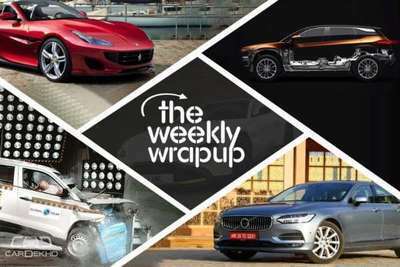Nutson Weekly Auto News Wrap-up June 5-11, 2022
 |
 |
LEARN MORE: Complete versions of today's news nuggets, along with thousands of pages of relevant news and opinions, information stored in a million-page library published and indexed on The Auto Channel during the past 25 years. Complete information can be found by copying a bold headline and then inserting into any Site Search Box.
Nutson's Automotive Weekly Auto News Wrap-up - Week Ending June 11 2022 Below are the past week's important, relevant, semi-secret, or snappy automotive news, opinions and insider back stories presented as expertly crafted easy-to-understand automotive universe news nuggets.
* The average price of gasoline nationwide topped $5/gallon early Saturday. How's your summer vacation plan coming along? TACH Solution Use More Ethanol
* Are you in need of a new car? Well! Overall new-vehicle buying conditions are a challenge right now for many would-be buyers. Not only are borrowing costs rising with higher interest rates, but higher gas prices are driving up vehicle operating costs as well. According to research from Kelley Blue Book, more shoppers are looking for smaller, fuel-efficient and electrified vehicles, but finding them on vehicle lots is proving a challenge. Inventory levels for hybrids and compact vehicles remain well below the industry average.
* The Alliance for Automotive Innovation is urging Congress to extend a tax credit for drivers who buy an electric vehicle – effectively reducing the up-front cost of the car or truck by up to $7,500. A targeted tax incentive for these drivers – not for millionaires – is a smart way to reduce the cost and encourage faster EV uptake and will have real spillover benefits like more private investment in EV charging infrastructure and a stronger, more competitive U.S. industrial base. A federal EV tax credit has been in place since 2007 when the auto landscape was much different. Under current law, the incentive phases down once an automaker sells just 200,000 EVs. Some companies have hit this cap (GM and Tesla). Toyota, Ford and Nissan will reach it soon.
* The Government Makes Your Mobility Choice When Biden administration said it is proposing a rule that would set minimum standards and requirements for federally funded electric vehicle charging stations. The standards will help ensure that a national EV charging network is accessible, user-friendly and interoperable between different charging companies and across a broad range of vehicles. The proposed rule includes a requirement to build EV charging stations every 50 miles, no more than 1 mile off the highway, and with a focus on the interstate system and alternative fuel corridors. Stations also would be required to have at least four 150-kilowatt direct-current fast-charging ports per station.
* Do you want to buy an EV but live in an apartment or condo complex and can't install a charger? Here's a solution. Audi plans to build luxury charging hubs for EV owners in more cities in Germany, after a successful pilot rollout in Nuremberg. The reservation-only charging hubs are aimed at EV owners who may not always have charging opportunities at home or work. The hubs, which average 35 visits per day, offer space to relax, work, and eat, and feature six charging spaces. The charging hub is neither a convenience store nor a restaurant in the traditional sense, but something closer to an airline lounge with staff, space to work, light refreshments, and even a grocery delivery service.
* New-vehicle average transaction prices (ATPs) increased to $47,148 in May 2022, according to new data released by Kelley Blue Book. Prices rose 1% ($472) month over month and remain elevated compared to one year ago, up 13.5% ($5,613) from May 2021. The average price paid for a new vehicle in the U.S. last month was the second-highest on record, behind only December 2021, when ATP reached $47,202. The average price paid for a new non-luxury vehicle last month was $43,338, up $709 from April. Car shoppers in the non-luxury segment paid on average $1,030 above sticker price. The average luxury buyer paid $65,379 for a new vehicle, down $511 month over month but still $1,071 above sticker price. The average price paid for a new electric vehicle (EV) dropped again in May compared to April, as more lower-priced models enter the market and offset the many luxury EVs already available.
* Roadway-embedded wireless charging for electric vehicles is coming to a stretch of urban highway in Detroit, marking a pilot-program first on a U.S. public road. Electreon’s patented wireless in-road EV charging technology already is in use with various European demonstration projects, including a 0.7-mile (1.05 km) intercity toll road in Italy and a 1-mi (1.65 km) public road in Sweden. Sweden’s policymakers aim to have 1,243 miles (2,000 km) of electrified roadway in operation by 2030. Detroit’s electrified roadway will be near Michigan Central, a mobility-innovation district under development by Ford Motor Co.
* Reuters said there’s more bad news about EV charging hassles. The Wall Street Journal last Saturday published a story describing an electric vehicle road trip from hell in a Kia EV6. Spoiler alert: It was really hard to find fast chargers between New Orleans and Chicago. Separately, a study of charging stations in the San Francisco Bay area found that roughly 1 in five public chargers didn’t work. At another 4.9% of the 657 public chargers assessed, the cable couldn’t reach the EVs plug. Yes, charging infrastructure and charger reliability are two issues needing to be addressed.
* Intelligent Speed Assistance (ISA), an in-vehicle safety system that warns or prevents drivers from exceeding the legal speed limit, is one of the key representative functions in the initiative to reduce the number and severity of road incidents and will become a mandatory requirement in the EU as of July 2022 in all new M and N category vehicle types.
* Boston is testing car-free zone in a popular square. Cars have been banned from Boston's Copley Square in a 10-day experiment during which the city will monitor traffic flow and pedestrian movements. Walking, rolling or biking without any cars is a dram of many. Data will be analyzed in consideration of permanently closing the street to vehicle traffic. If you've visited many a European city you know this scenario has existed for many years.
* From Autoweek we read: Believe it or not, rubber particulates from tires may pollute more than gasses emitted from vehicle tailpipes. Varying by compound, the emissions created by tires come in the form of expelled rubber particles which eventually reach waterways or soak into nearby soil. According to Emissions Analytics, a UK-based vehicle data specialist, tire-wear particles account for emissions at a rate 16 times greater than the maximum tailpipe emissions allowed for modern cars in the UK. Over a tire's lifespan, it will emit an average of 1850 times more particles than the actual tailpipe emissions of a modern gas car.
* Joe White writing for Reuters points out the a lot of Millennials are having kids. And that appears to be reviving demand for minivans - a vehicle form left for dead by most mainstream automakers. Prices for second-hand vans and minivans are up more than 27% in May compared to a year ago, according to the latest Manheim Used Vehicle Value Index. U.S. birth rates are rising. And when you’re hoisting car seats and diaper bags, those sliding doors and big cargo bays can overcome fears of becoming your parents.
* The North American Car, Truck and Utility Vehicle of the Year (NACTOY) Awards said it expects a total of 47 cars, trucks and utility vehicles to be eligible for the 2023 awards – tying with 2019 for the most eligible vehicles in the history of the awards. As of June 9, automakers have confirmed plans to launch 13 all-new or substantially new cars, three trucks and 31 utility vehicles this year in North America that meet NACTOY’S eligibility requirements. Among the 47 vehicles are 19 battery electric vehicles, the highest number of EVs ever. Two out of three pickups in the truck category are electric.
* Reuters reports U.S. regulators are stepping up their investigations of Autopilot, the semi-automated driving assistance technology that has become a signature feature for Tesla. The National Highway Traffic Safety Administration said it has escalated its investigation of Autopilot to an “engineering analysis,” which is a step the agency takes before it orders a recall. The action covers 830,000 Tesla vehicles. The impact of an Autopilot recall could go beyond Tesla. In a document explaining the action, NHTSA officials make clear that their concerns about Autopilot are fairly broad, and include the design and function of systems that are supposed to monitor drivers and assure that they are still in control of the car, and paying attention. NHTSA also signaled that it could order a recall or a redesign of Autopilot - or similar assisted driving systems used by other manufacturers - even if it concludes that drivers misused the systems or ignored warnings.
* Toro, the yard equipment maker, is now marketing an autonomous lawn mower that looks like the offspring of R2D2 and a Roomba. Toro said the robo-mower will start shipping next spring. Price undisclosed, but the company suggests it will be in the ballpark of human-operated zero turn mowers, which go for $4,000 and up.
* Penske Racing scored two wins last weekend. One was in IndyCar at the last race to be held at Detroit's Belle Isle circuit. The other in NASCAR at the first race held at World Wide Technology Raceway, more commonly referred to as Gateway, just across the Mississippi River from St. Louis. The Enjoy Illinois 300 was the first event ever to sell out Gateway in the track’s history with Penske’s Joey Logano in his Ford taking the win. Will Power took the win at the Detroit Gran Prix in his Team Penske-Chevrolet at Belle Isle.
* The Detroit Grand Prix began as a downtown street race for Formula One in 1982 (I was there) and closed after a seven year run. With F1 sanctioning and fees being very expensive the race was rebranded for CART. That ended in 1991 and the event moved the next year to the 2.35-mile temporary circuit on Belle Isle.
* The 90th 24 Hours of Le Mans is this weekend and we hope you have been following the coverage. The Le Mans racetrack is located just outside of Le Mans, France, and is named Circuit de la Sarthe. It is 8.467 miles long and is comprised of a combination of designated racetrack and public roads that are shut down for the race each year. About 60 cars are entered and each car has three drivers.
Stay safe. Be Well.


